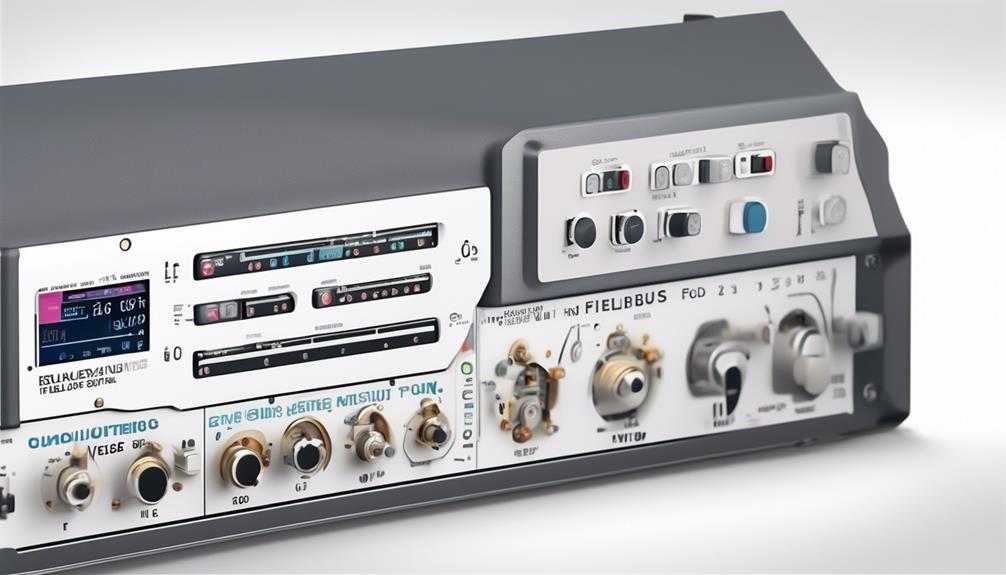Fieldbus is essentially the central nervous system of industrial automation, intricately linking different components to guarantee smooth and effective operations. Its evolution and widespread acceptance have transformed the transmission and control of data in a variety of industrial settings.
However, as technology continues to advance, the question arises: can Fieldbus keep up with the changing demands of industrial automation? Let's explore the evolution, key features, and potential challenges of Can Fieldbus to understand its role in the ever-evolving landscape of industrial control systems.
Key Takeaways
- CAN Fieldbus was developed by Bosch in 1983 and was originally designed for the automotive industry, but is now widely used in industrial control and automation.
- Fieldbus systems have evolved from proprietary technologies to open standards-based systems, with the integration of Industrial Ethernet and the development of international standards.
- CAN Fieldbus offers support for various network topologies, advanced control functionality, application-specific protocols, and compliance with international standards, making it a reliable and efficient industrial communication system.
- In industrial settings, CAN Fieldbus enables seamless connection of devices, real-time distributed control, reduction in wiring complexity, and support for various protocols, leading to streamlined communication and enhanced scalability.
Overview of CAN Fieldbus
We'll delve into the overview of CAN Fieldbus, a widely utilized communication protocol in various industries since its development by Bosch in 1983. The CAN protocol, initially designed for the automotive industry, has found extensive applications in industrial control and automation, facilitating synchronized data exchange between control devices. CAN Fieldbus has become integral in connecting industrial devices, forming a robust network for the seamless transmission of data. This protocol has revolutionized industrial networks, enabling efficient communication and control within automated systems.
The CAN Fieldbus operates using a multimaster-capable, event-oriented message transmission, allowing each node to initiate message transfer, ensuring efficient data exchange among connected devices. With its priority-oriented communication, CAN Fieldbus optimizes the utilization of available bandwidth, enhancing the ability to detect transmission errors while ensuring short recovery times and minimized additional busload. The protocol's lossless, bitwise arbitration mechanism further ensures smooth message transfer and efficient bandwidth utilization, making it an ideal choice for industrial automation and control applications.
CAN Fieldbus's versatility and reliability have cemented its position as a cornerstone in modern industrial networks.
History and Evolution

Tracing the history and evolution of fieldbus systems reveals a significant shift towards reducing installation and maintenance costs while accommodating a large number of sensors and actuators. Fieldbus systems have played a pivotal role in the evolution of industrial communication and automation technology.
Initially, fieldbus systems were proprietary, limiting interoperability and flexibility. However, the development of open fieldbus standard-based technologies like Foundation Fieldbus and Profibus revolutionized industrial networking. This shift allowed for seamless integration of diverse devices, fostering enhanced industrial applications.
The evolution of fieldbus networks has been marked by the emergence of advanced communication protocols and standards. The integration of Industrial Ethernet into fieldbus systems has further enhanced their capabilities, enabling high-speed, real-time communication and greater bandwidth for industrial applications. Additionally, the standardization of fieldbuses has led to the development of international standards, promoting interoperability and driving innovation.
The history of fieldbus systems showcases a progression towards more efficient and cost-effective industrial networks. This evolution has significantly impacted the automation industry, providing enhanced connectivity, proactive maintenance diagnostics, and support for diverse industrial applications across various sectors.
Key Features and Functionality
Fieldbus systems offer a range of key features and functionality that streamline industrial communication and automation processes. These include:
- Support for Various Network Topologies: Fieldbus systems are designed to support different network topologies, reducing the need for lengthy and numerous cables for communication. This flexibility in network design contributes to efficient and adaptable communication systems.
- Advanced Control Functionality: Fieldbus devices often feature microprocessors and support control schemes, allowing for efficient and flexible industrial automation. This enables precise control over digital points, input devices, and output devices, enhancing the overall functionality of the system.
- Application-Specific Protocols: Different fieldbus protocols cater to various applications such as industrial automation, process automation, and building automation. This ensures that the system can be tailored to meet specific industry requirements, enhancing its functionality and adaptability.
- International Standard Compliance: Fieldbus networks adhere to international standards, ensuring interoperability and compatibility at a technical level. This standardization promotes seamless integration and communication within the system, contributing to its key functionality as a reliable and efficient industrial communication system.
Applications in Industrial Settings

Moving from the discussion of key features and functionality, we can now explore the diverse applications of Fieldbus in industrial settings.
Fieldbus technology revolutionizes communication and control in industrial environments. It facilitates the seamless connection of numerous devices such as sensors, actuators, and programmable logic controllers (PLCs), enabling efficient data exchange and control.
In industrial settings, Fieldbus plays a pivotal role in optimizing processes by enabling real-time distributed control and enhancing system diagnostics for proactive and predictive maintenance strategies.
Additionally, Fieldbus supports various protocols like PROFIBUS, Foundation Fieldbus, and Controller Area Network (CANopen), catering to a wide range of industrial automation applications across different layers of the OSI model.
Its ability to support different network topologies reduces the complexity of wiring and enhances the scalability of industrial communication networks.
This technology not only streamlines the communication between devices but also supports advanced control schemes, making it an indispensable asset in modern industrial settings.
Advantages and Considerations
Upon implementation, Fieldbus technology streamlines communication and control in industrial environments, offering a myriad of advantages and considerations to be taken into account.
- Cost Efficiency: Fieldbus reduces the length and number of cables required for communication, leading to cost savings and easier installation, especially in systems with numerous field devices such as sensors and actuators.
- Scalability and Centralized Control: It allows for hundreds of devices to connect simultaneously, enabling efficient and centralized control in industrial settings, promoting flexibility in the deployment of programmable logic controllers (PLCs).
- Enhanced Reliability and Maintenance: Fieldbus networks provide diagnostics for proactive maintenance and predictive strategies, enhancing overall system reliability and availability. This enhances the data communication and control bus capabilities, reducing downtime in industrial systems.
- Interoperability and Compatibility: Fieldbus standards promote interoperability and compatibility among devices, facilitating seamless integration and scalability in industrial applications. However, consideration of different protocols and careful planning is necessary to ensure optimal performance and security in complex industrial environments.
As we delve into the advantages and considerations of Fieldbus technology, it becomes evident that its implementation requires a comprehensive understanding of computer networks, different protocols, and the specific requirements of systems in industrial settings.
Frequently Asked Questions
Is Canbus a Fieldbus?
Yes, Canbus technology is a type of fieldbus communication commonly used in industrial applications. It's a network protocol that enables efficient data transmission in control systems.
Originally developed for the automotive industry, Canbus technology supports priority-oriented communication and robust signal processing. It follows protocol standards for communication networks and provides high data transmission security.
Its lossless arbitration process ensures smooth message transfer and makes it suitable for various industrial applications.
What Are the Two Types of Fieldbus?
The two types of fieldbus, Foundation Fieldbus and Profibus, are essential for industrial applications. They provide advanced network communication, protocol standards, and high-speed data transmission for control systems and automation technology.
Foundation Fieldbus excels in process optimization and real-time monitoring. It allows for the integration of intelligent field devices, enabling better control and optimization of industrial processes. This type of fieldbus is particularly suitable for industries that require precise control and monitoring, such as chemical plants and oil refineries.
On the other hand, Profibus is known for its device interoperability and integration challenges. It offers a wide range of devices from different manufacturers, allowing for flexibility in system design. However, the integration of these devices can be complex and may require additional configuration and troubleshooting.
Understanding these differences is crucial for selecting the right solution for specific industrial applications. Depending on the requirements of the industry, either Foundation Fieldbus or Profibus may be the better choice. It is important to assess the specific needs of the application, such as real-time monitoring or device interoperability, in order to make an informed decision.
What Is the Difference Between Fieldbus and Plc?
What's the difference between fieldbus and PLC?
Fieldbus applications focus on network communication, data exchange, device connectivity, and signal transmission in industrial automation.
PLC integration, on the other hand, emphasizes control systems and system architecture.
Fieldbus protocols enable multiple devices to connect to a single network, while PLCs are standalone devices programmed for specific functions.
Both play crucial roles in industrial automation, with Fieldbus offering a more interconnected approach and PLCs focusing on specific control tasks.
How Does a Fieldbus Work?
Fieldbus communication in industrial automation involves network protocols for data transmission, control systems, device integration, signal processing, and communication protocols.
It enables real-time control through a specialized network architecture. Fieldbus optimizes data transmission between devices, reducing cabling and enhancing system diagnostics. It supports various topologies, fostering distributed control and monitoring.
Conclusion
So, in conclusion, Can Fieldbus has really simplified our lives in industrial automation. It's amazing how something designed to reduce wiring complexity has actually made things more intricate. But hey, that's progress for you, right?
Who knew that making things simpler could actually make them more complex? Just another fantastic irony of modern technology.










